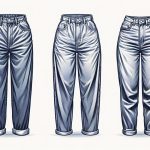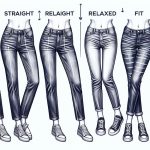Are you tired of wrinkled denim ruining your stylish outfits? Well, look no further! This article will guide you through the process of ironing denim fabric, ensuring that your jeans, jackets, and skirts look crisp and polished.
From choosing the right iron temperature to handling tricky details like pockets and seams, we’ve got you covered. Say goodbye to wrinkled denim and hello to perfectly pressed outfits.
Let’s get started!
Table of Contents
Choosing the Right Iron Temperature
When ironing denim fabric, it’s important to choose the right iron temperature. One of the key factors in achieving a crisp, wrinkle-free finish is maintaining your ironing tools. Ensure that your iron is clean and free from any residue or buildup, as this can transfer onto your denim and affect the final result. Additionally, check that the iron’s steam settings are functioning properly, as steam can be quite effective in removing stubborn wrinkles.
Another aspect to consider when ironing denim is the different washes of denim fabric. Dark wash denim, for example, should be ironed at a higher temperature to help set the color and maintain its rich hue. On the other hand, lighter washes or distressed denim may require a lower iron temperature to prevent any potential damage to the fabric. It’s always a good idea to test a small, inconspicuous area of your denim before ironing the entire garment, just to be sure you have the right temperature setting.
Preparing Your Denim for Ironing
When it comes to ironing denim effectively and avoiding heat damage, there are a few key points to keep in mind.
First, you’ll want to make sure that your iron is set to the appropriate temperature for denim fabric.
Second, it’s important to use a pressing cloth or ironing inside out to protect the fabric from direct heat.
Lastly, be mindful of how much pressure you apply while ironing, as excessive force can lead to unwanted creases or even scorching.
Ironing Denim Effectively
Ironing denim effectively can be achieved by using a steam iron. When it comes to choosing ironing tools for denim, a steam iron is your best bet. The steam helps to relax the fibers and smooth out any wrinkles, giving your denim a crisp and polished look. Additionally, it is important to prevent wrinkles while ironing denim. One way to do this is by laying the denim flat on the ironing board and smoothing it out with your hands before applying the iron. Another tip is to iron in sections, starting from the top and working your way down, to ensure even and effective ironing. By following these tips and using a steam iron, you can achieve perfectly ironed denim every time.
| Choosing Ironing Tools | Preventing Wrinkles |
|---|---|
| Steam Iron | Lay denim flat |
| Smooth with hands | |
| Iron in sections | |
| Start from the top |
Avoiding Heat Damage
To prevent heat damage, it’s important to adjust the temperature settings on your steam iron accordingly. Follow these steps to avoid scorch marks and protect your denim fabric:
- Set the iron to the appropriate temperature for denim (usually medium-high heat).
- Always start ironing from the inside of the fabric to prevent direct contact between the hot iron and the denim.
- Use a pressing cloth, such as a clean cotton cloth or a thin towel, to create a barrier between the iron and the denim. This will help distribute heat evenly and prevent scorching.
By adjusting the temperature, ironing from the inside, and using a pressing cloth, you can effectively prevent heat damage to your denim fabric.
Remember to always test the iron on a small, inconspicuous area before ironing the entire garment to ensure that the temperature is suitable and won’t cause any damage.
Ironing the Inside of Denim Fabric
Don’t forget to press the inside of the denim fabric to achieve a smooth finish.
When ironing denim, it’s important to pay attention to both the outside and inside of the fabric to ensure a crisp and wrinkle-free result.
To start, set your iron to the appropriate temperature for denim, usually medium-high heat.
Place the denim garment on the ironing board with the wrong side facing up. Gently smooth out any wrinkles or creases by hand.
Begin ironing the inside of the fabric, starting from the top and working your way down. Use firm, but not excessive pressure, and move the iron in long, sweeping motions.
Be careful not to linger in one spot for too long, as this can cause shiny marks on the fabric.
If you encounter stubborn wrinkles, try using a steam function on your iron or lightly mist the fabric with water before ironing.
Additionally, be mindful of any decorative buttons or embellishments on the inside of the fabric to avoid damaging them.
Ironing the Outside of Denim Fabric
When ironing the outside of denim fabric, there are a few key points to keep in mind.
First, it’s important to avoid using excessive heat, as this can damage the fabric and cause it to lose its shape.
Additionally, using steam carefully can help to remove wrinkles without causing any harm to the denim.
Avoid Excessive Heat
Using too much heat can damage denim fabric, so it’s important to be cautious while ironing. Here are some tips to help you avoid excessive heat and protect your denim:
-
Heat control:
-
Set your iron to the appropriate temperature for denim fabric. Too high of a heat setting can cause the fabric to scorch or fade.
-
Use a lower heat setting for delicate denim, such as lightweight or stretch denim.
-
If you’re unsure about the right temperature, start with a lower setting and gradually increase it if needed.
-
Ironing techniques:
-
Always iron denim fabric on the reverse side to prevent any potential damage to the front.
-
Use a pressing cloth or a thin cotton fabric between the iron and the denim to protect the fabric from direct heat.
-
Avoid leaving the iron in one spot for too long to prevent creating shiny or faded patches on the fabric.
Use Steam Carefully
Be cautious with steam, as too much can cause damage to your clothing.
When using steam to remove wrinkles from your clothes, it is important to use it safely and prevent water spots.
First, make sure your iron is set to the appropriate steam setting for the fabric you are ironing. Too much steam on delicate fabrics can lead to water spots.
Start by testing the steam on a small, inconspicuous area of the garment to ensure it won’t cause any damage.
When steaming, hold the iron a few inches away from the fabric and move it in a sweeping motion to evenly distribute the steam. Avoid saturating the fabric with too much steam to prevent water spots from forming.
Handling Denim Details, Such as Pockets or Seams
To handle denim details like pockets or seams, you’ll need to be careful not to press too hard and create unwanted creases. Delicate denim requires a gentle touch when ironing to prevent damage and maintain the fabric’s integrity.
Here are some tips to help you handle denim details effectively:
-
Use a lower heat setting: Set your iron to a medium or low heat to avoid scorching the denim fabric. High heat can cause the threads to weaken and result in unwanted creases.
-
Place a cloth between the iron and the denim: To further protect the delicate denim, place a thin cloth, such as a cotton handkerchief or a pressing cloth, over the denim detail before ironing. This will provide an extra layer of protection and prevent direct contact with the hot iron.
-
Iron in a circular motion: Instead of pressing down on the denim detail, gently move the iron in a circular motion. This technique helps distribute the heat evenly and prevents concentrated pressure on one spot, reducing the risk of creating creases.
Tips for Maintaining the Quality of Ironed Denim
By following these tips, you can safely maintain the quality of your ironed denim details like pockets or seams. Maintaining ironed denim is crucial to keep it looking fresh and wrinkle-free.
One important tip to prevent creasing is to always hang your ironed denim after wearing it. Folding it immediately can cause creases to form, especially in areas like pockets or seams. If you don’t have space to hang it, consider using a hanger with clips to hang it by the waistband or belt loops.
Another tip is to avoid over-ironing your denim. Excessive heat can damage the fabric and cause it to lose its shape. Use a medium heat setting and always iron on the reverse side to protect the outer surface. Additionally, it’s a good idea to use a pressing cloth or a thin towel between the iron and the denim to prevent direct heat contact.
Lastly, avoid using too much pressure when ironing. Gently glide the iron over the fabric to smooth out any wrinkles.
Conclusion
In conclusion, ironing denim fabric can be a simple task if you follow the right steps.
Remember to choose the appropriate iron temperature and prepare your denim by removing any wrinkles or creases.
When ironing, start with the inside of the fabric, then move on to the outside.
Take care when ironing denim details, such as pockets or seams.
Lastly, make sure to maintain the quality of your ironed denim by avoiding excessive heat and following proper care instructions.
Happy ironing!
- How Does Ring Spun Cotton Affect Garment Fit and Shape Retention? - August 13, 2024
- What Are the Challenges in Producing Ring Spun Cotton? - August 13, 2024
- Is Ring Spun Cotton Suitable for Plus-Size Clothing? - August 13, 2024




